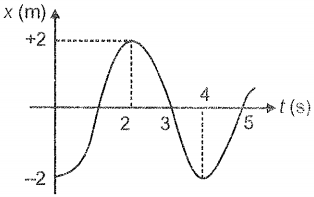A particle moves according . Average velocity of the particle in the time interval between t = 0 to t = 3 s is
1. 1 cm/s
2. 3.5 cm/s
3. 2 cm/s
4. 6 cm/s
A particle performs SHM with frequency \(f.\) The frequencies of its velocity and acceleration are, respectively:
| 1. | \(f,~f\) | 2. | \(\dfrac{f}{2},~f\) |
| 3. | \(2f,~f\) | 4. | \(f,~2f\) |
Force acting on a body free to move on the \(\mathrm{X}\)-axis is given by, \(F=-kx^n \) where \(k\) is a positive constant. For which value of \(n\) motion of the body is not oscillatory?
1. \(3\)
2. \(7\)
3. \(2\)
4. \(5\)
In a forced oscillation, when the system oscillates under the action of the driving force in addition to its internal restoring force, the particle oscillates with a frequency equal to
1. The natural frequency of the body
2. Frequency of driving force
3. The difference in frequency of driving force and natural frequency
4. Mean of the driving frequency and natural frequency
The potential energy of a harmonic oscillator at equilibrium is 15 J and average kinetic energy is 5 J. Total energy at any instant is
1. 25 J
2. 5 J
3. 15 J
4. 40 J
A particle is executing S.H.M. Graph of its displacement with the position is shown in the figure. Maximum acceleration of the particle is

1.
2.
3.
4.
A uniform spring has a force constant K. It is cut into two pieces of lengths , such that . Time period of oscillation of a mass m with spring of length is
1.
2.
3.
4.
A body executes oscillations under the effect of a small damping force. If the amplitude of the body reduces by 50% in 6 minutes, then amplitude after the next 12 minutes will be [initial amplitude is ] -
1.
2.
3.
4.
A particle is executing SHM along a straight-line path. Then which of the following statement is correct?
1. Acceleration always decreases the speed of the particle
2. Acceleration is constant with time
3. Acceleration is constant with position
4. Acceleration is maximum when the particle is at rest
Two pendulums A and B of length 144 cm and 100 cm are initially in the same phase at their equilibrium positions. After how much complete oscillations of B, they come in the same phase?
1. 4
2. 6
3. 8
4. 10






